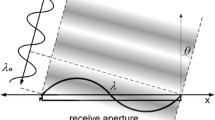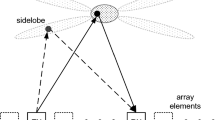Abstract
Purpose
We propose a new method of estimating the side lobe levels from received ultrasound channel data.
Methods
Ultrasound signals impinging on an array transducer manifest themselves as sinusoids whose spatial frequency varies as a function of the incident angle. The received channel data from the main lobe direction have a spatial frequency of zero when considered across all the channels because individual channel data have the same phase in the temporal domain, while those from the side lobe directions have a spatial frequency that is not zero and varies with the ultrasound beam incident direction. Thus, the received channel data can be modeled as a sinusoidal waveform that has a specific frequency depending on the incident angle. The side lobe components are modeled as a sum of sinusoidal waves that have a frequency equal to an integer plus a half. We estimated the side lobe waveform that has an integer-plus-a-half frequency by adaptively varying the window length in the spectrum estimation. The effect of side lobes on ultrasound image can be reduced by subtracting the estimated side lobe waveform in receive focusing.
Results
To confirm the efficacy of the proposed method, ultrasound field simulations and experiments were carried out. We observed that the 1st to 5th spatial frequency side lobes estimated using the proposed method were present at the same positions as the side lobes in the field response. By subtracting the waveforms of the 1st to 20th spatial frequency side lobes, we reduced the side lobe levels by up to 14 dB. Experiments on wire phantoms in a water tank also confirmed that the proposed method can estimate and reduce the side lobe levels.
Conclusions
We have proposed a new method of estimating and canceling side lobes that is validated through both simulation and experiment.
Similar content being viewed by others
References
Macovski A. Medical imaging systems. Englewood Cliffs: Prentice Hall; 1983.
Kim JH, Song TK, Park SB. Pipelined sampled delay focusing in ultrasound imaging. Ultrason Imaging. 1987; 9(2):75–91.
Fink M, Kuperman WA, Montagner JP, Tourin A. Imaging of complex media with acoustic and seismic waves. Berlin: Springer; 2002.
Van Veen BD, Buckley KM. Beamforming: A versatile approach to spatial filtering. IEEE ASSP Mag. 1988; 5(2):4–24.
Viola F, Walker WF. Adaptive signal processing in medical ultrasound beamforming. Conf Proc IEEE Ultrason Symp. 2005; 4:1980–3.
Nilsen CIC, Hafizovic I. Beamspace adaptive beamforming for ultrasound imaging. IEEE T Ultrason Ferr. 2009; 56(10):2187–97.
Nilsen CIC, Holm S. Wiener beamforming and the coherence factor in ultrasound imaging. IEEE T Ultrason Ferr. 2010; 57(6):1329–46.
Kim K, Park S, Kim J, Park SB, Bae M. A fast minimum variance beamforming method using principal component analysis. IEEE T Ultrason Ferr. 2014; 61(6):930–45.
Hollman KW, Rigby KW, O’Donnell M. Coherence factor of speckle from a multi-row probe. Conf Proc IEEE Ultrason Symp. 1999; 2:1257–60.
Li PC, Li ML. Adaptive imaging using the generalized coherence factor. IEEE T Ultrason Ferr. 2003; 50(2):128–41.
Camacho J, Parrilla M, Fritsch C. Phase coherence imaging. IEEE T Ultrason Ferr. 2009; 56(5):958–74.
Lediju MA, Trahey GE, Byram BC, Dahl JJ. Short-lag spatial coherence of backscattered echoes: imaging characteristics. IEEE T Ultrason Ferr. 2011; 58(7):1377–88.
Dahl JJ, Trahey GE. Off-axis scatterer filters for improved aberration measurement. Conf Proc IEEE Ultrason Symp. 2003; 1094–7.
Jeong MK. A Fourier transform-based sidelobe reduction method in ultrasound imaging. IEEE T Ultrason Ferr. 2000; 47(3):759–63.
Byram B, Dei K, Dumont D. An improved acoustic clutter model and direct in vivo assessment of off-axis and multipath clutter energy in the liver. Conf Proc IEEE Ultrason Symp. 2014; 1:531–4.
Byram B, Jakovljevic M. Ultrasonic multipath and beamforming clutter rejection: A chirp model approach. IEEE T Ultrason Ferr. 2014; 61(3):428–40.
Ziomek LJ. Fundamentals of acoustic field theory and spacetime signal processing. Boca Raton: CRC Press; 1994.
Oppenheim AV, Schafer RW. Discrete-time signal processing. 3rd ed. Upper Saddle River: Pearson Education; 2009.
Jensen JA. Field: A program for simulating ultrasound systems. Med Biol Eng Comput. 1996; 34(1):351–3.
Author information
Authors and Affiliations
Corresponding author
Rights and permissions
About this article
Cite this article
Jeong, M.K., Kwon, S.J. Estimation of side lobes in ultrasound imaging systems. Biomed. Eng. Lett. 5, 229–239 (2015). https://doi.org/10.1007/s13534-015-0194-y
Received:
Revised:
Accepted:
Published:
Issue Date:
DOI: https://doi.org/10.1007/s13534-015-0194-y




